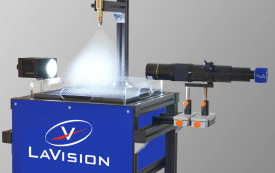方案详情文
Liquid flows incorporating small-size bubbles play a vital role in many industrial applications. In
this work, an experimental investigation is conducted on bubble formation during gas injection from
a microtube into the channel of a downward liquid cross flow. The tip of the air injector has been
located at the wall wall orifice and also at several locations from the wall to channel centerline
nozzle injection. The size, shape, and velocity of the bubbles along with liquid velocity field are
measured using a shadow-particle image velocimetry/particle tracking velocimetry system. The
process of bubble formation for the wall orifice and the nozzle injection configurations is physically
explained. The effect of variation in water and air flow rates on the observed phenomena is also
investigated by considering water average velocities of 0.46, 0.65, and 0.83 m/s and also air average
velocities of 1.32, 1.97, 2.63, and 3.29 m/s. It was observed that shifting the air injector tip toward
the center of the channel resulted in the coalescence of some of the preliminary bubbles and the
formation of larger bubbles termed secondary and multiple bubbles. Increase in air flow rate and
reduction in water flow rate also intensify the rate of bubble coalescence. A correlation-based model
is also suggested to overcome the shortcoming of the available models in the literature which are
developed to only estimate the size of the preliminary bubbles. The model predicts the percent of the
preliminary, secondary, and multiple bubbles along with the average size of secondary and multiple
bubbles as a function of nozzle position within a cross flow.
智能文字提取功能测试中
关闭产品配置单
北京欧兰科技发展有限公司为您提供《液体交叉流中气体注入位置对其气泡形成的影响检测方案 》,该方案主要用于其他中气体注入位置对其气泡形成的影响检测,参考标准《暂无》,《液体交叉流中气体注入位置对其气泡形成的影响检测方案 》用到的仪器有德国LaVision PIV/PLIF粒子成像测速场仪、LaVision ParticleMaster-Shadow 粒径测量系统。
我要纠错
推荐专场
相关方案









 咨询
咨询